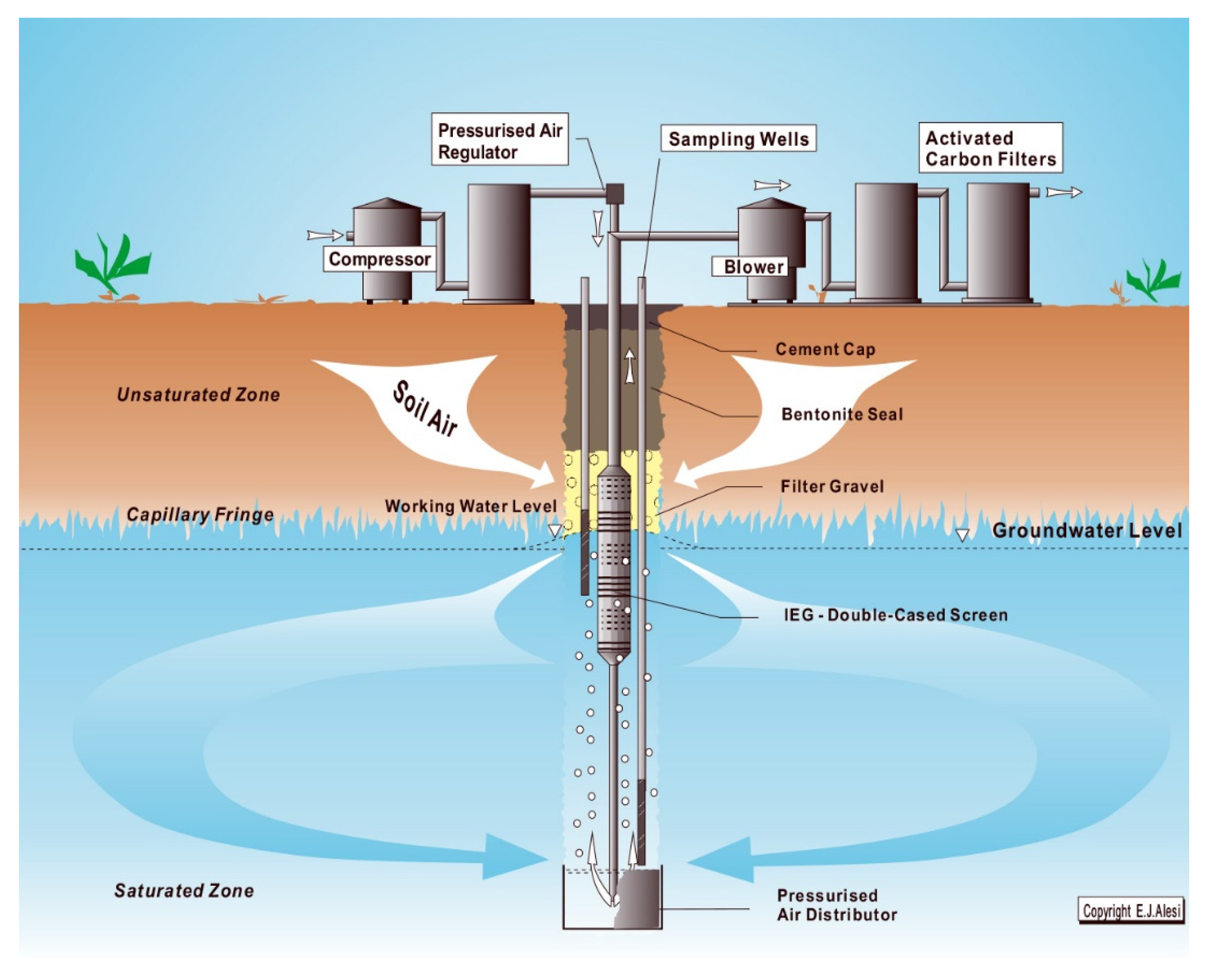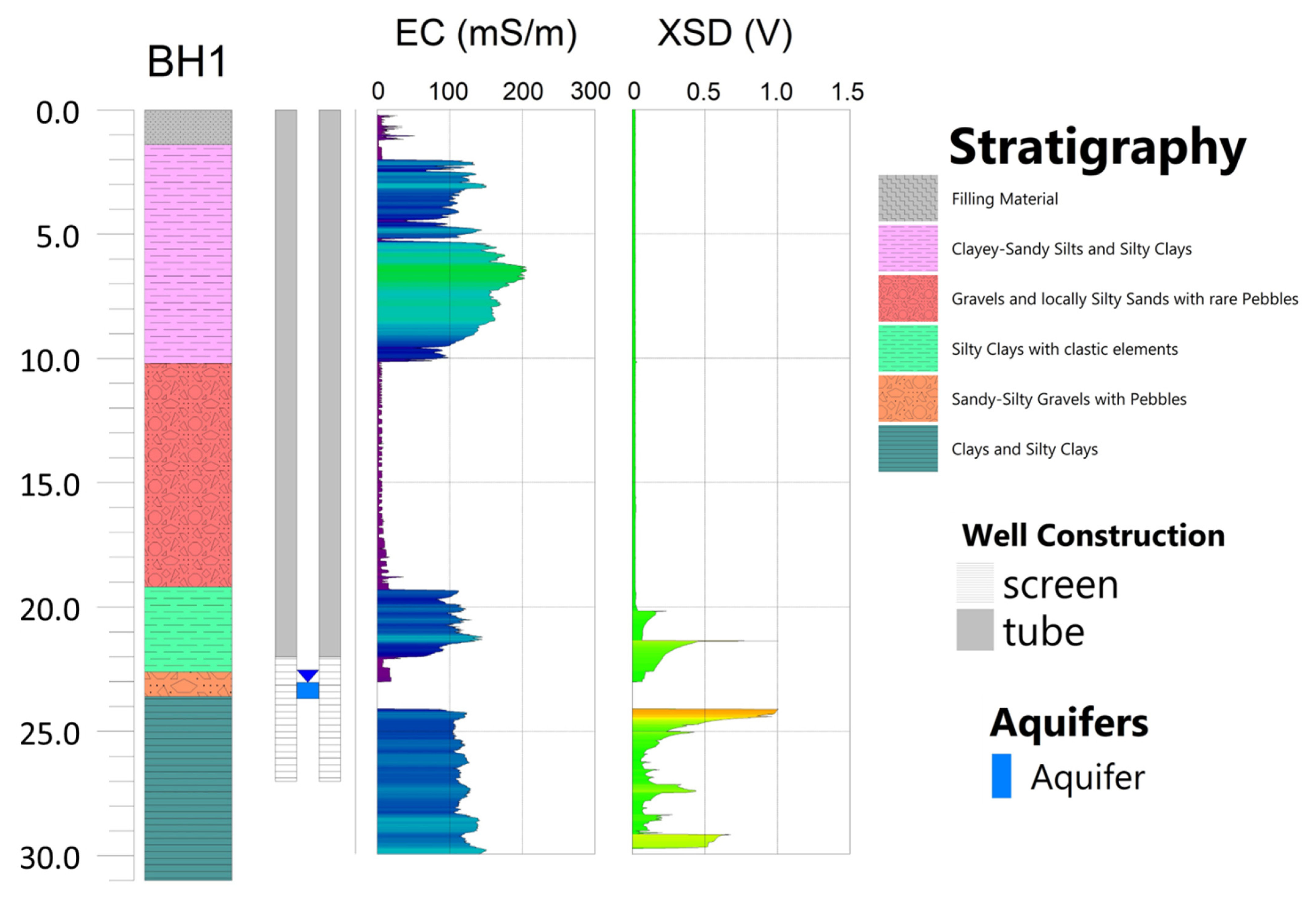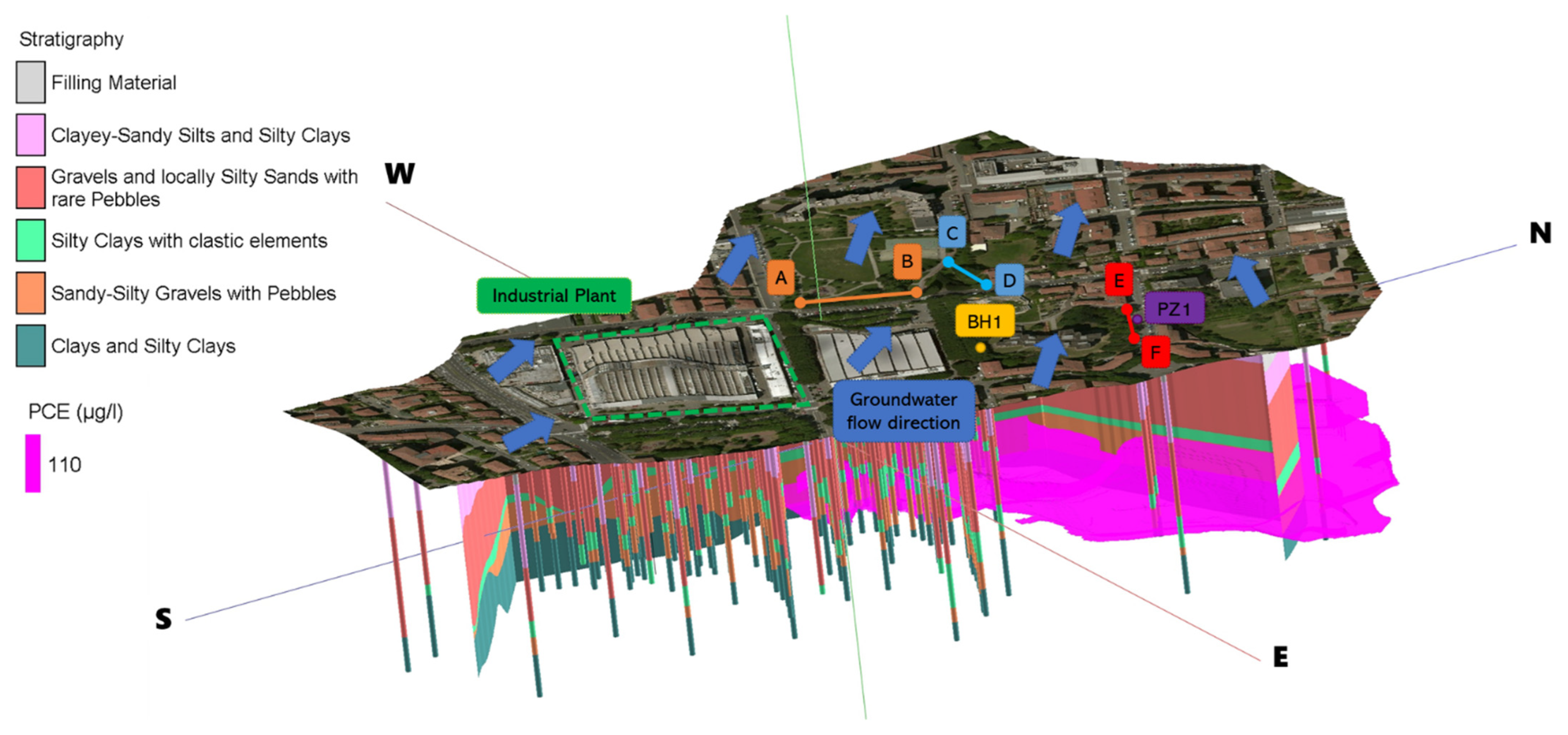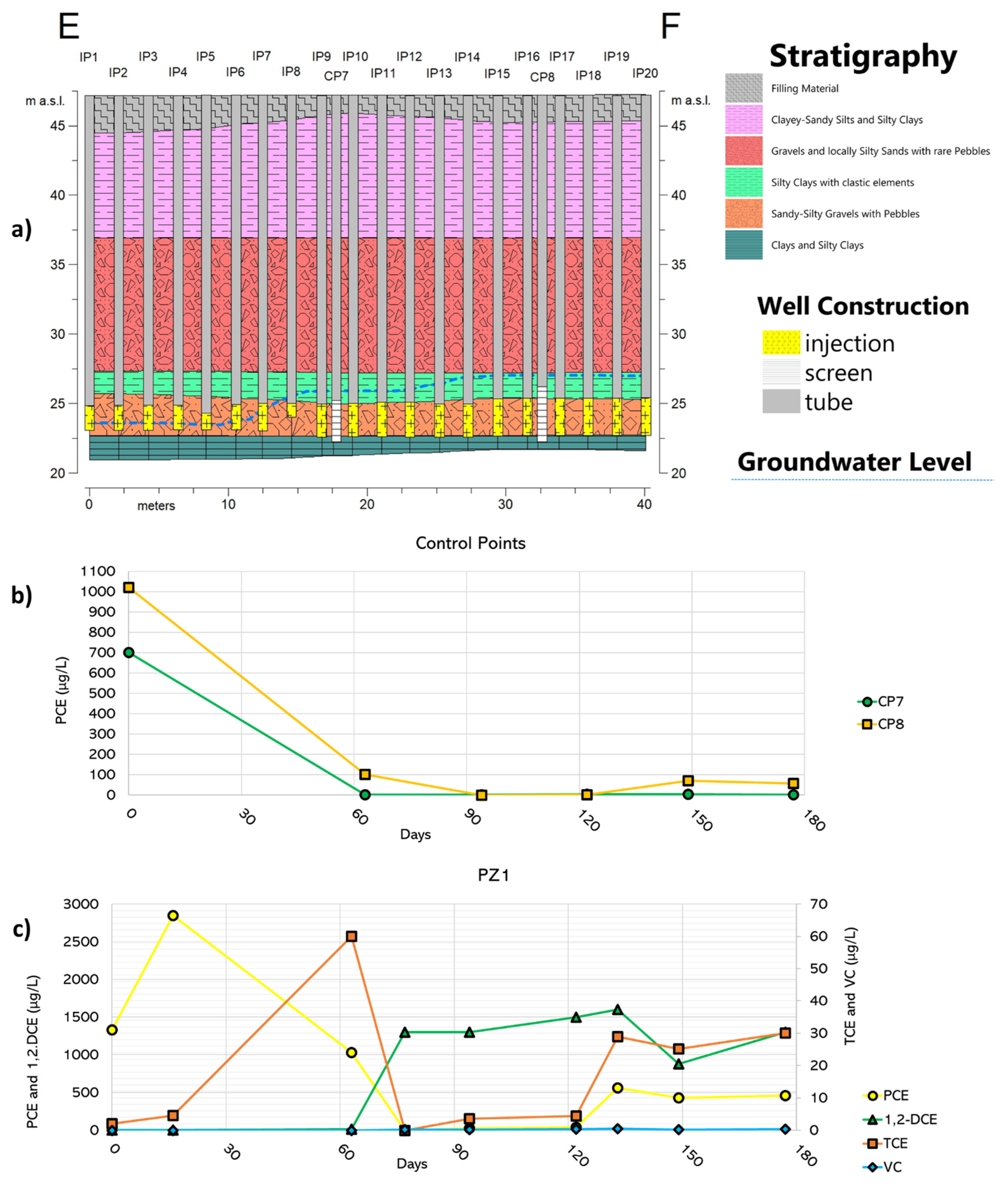Coupled Hydrogeochemical Approach and Sustainable Technologies for the Remediation of a Chlorinated Solvent Plume in an Urban Area
Abstract
1. Introduction
1.1. Pollution Caused by Chlorinated Solvents: Dynamics and Processes
1.2. The Site Characterization and Big Data Package for Decision Making
1.3. The Research Problem
2. Materials and Methods
2.1. The Multi-Source and Geodatabase-Driven Modeling Approach
2.2. Remediation Strategy with IEG CGC-AS® Systems, Activated Carbon, and Zero-Valent Iron Injections
3. Results and Discussion
3.1. Conceptual Model: Geological and Hydrochemical Portrait of the Site
- Heterogeneous filling material from 0 to 1 m;
- Alternations of clays, more or less silty, with sandy-clay silts from 1 to 10 m;
- Gravels and sands that appear locally slightly silty with rare pebbles from 10 to 19–20 m;
- Alternating clays and silty clays with intercalations of silts that appear clayey to slightly sandy, varying in thickness from 0 to 4–5 m;
- Gravels and sands, with rare pebbles, presenting in some parts weakly silty fractions, with a thickness varying between 1 and 8 m, generally found between 22 m and 24 m of depth;
- Silty clays from 24 to 33 m depth.
3.2. Configuration and Performance of IEG CGC-AS® Barriers
3.3. The Impact of the Adsorbent and Reducing Barrier in the Peculiar Hydrogeological Framework
4. Conclusions
Supplementary Materials
Author Contributions
Funding
Institutional Review Board Statement
Informed Consent Statement
Data Availability Statement
Acknowledgments
Conflicts of Interest
References
- Filippini, M.; Nijenhuis, I.; Kümmel, S.; Chiarini, V.; Crosta, G.; Richnow, H.H.; Gargini, A. Multi-element compound specific stable isotope analysis of chlorinated aliphatic contaminants derived from chlorinated pitches. Sci. Total Environ. 2018, 640–641, 153–162. [Google Scholar] [CrossRef] [PubMed]
- Rivett, M.O.; Turner, R.J.; Murcott, P.G.; Cuthbert, M.O. The legacy of chlorinated solvents in the Birmingham aquifer, UK: Observations spanning three decades and the challenge of future urban groundwater development. J. Contam. Hydrol. 2012, 140–141, 107–123. [Google Scholar] [CrossRef] [PubMed]
- Walaszek, M.; Cary, L.; Billon, G.; Blessing, M.; Bouvet-Swialkowski, A.; George, M.; Criquet, J.; Mossmann, J.R. Dynamics of chlorinated aliphatic hydrocarbons in the Chalk aquifer of northern France. Sci. Total Environ. 2021, 757, 143742. [Google Scholar] [CrossRef]
- Wang, X.; Xin, J.; Yuan, M.; Zhao, F. Electron competition and electron selectivity in abiotic, biotic, and coupled systems for dechlorinating chlorinated aliphatic hydrocarbons in groundwater: A review. Water Res. 2020, 183, 116060. [Google Scholar] [CrossRef]
- Wu, N.; Zhang, W.; Wei, W.; Yang, S.; Wang, H.; Sun, Z.; Song, Y.; Li, P.; Yang, Y. Field study of chlorinated aliphatic hydrocarbon degradation in contaminated groundwater via micron zero-valent iron coupled with biostimulation. Chem. Eng. J. 2020, 384, 123349. [Google Scholar] [CrossRef]
- Mackay, D.M.; Roberts, P.V.; Cherry, J.A. Transport of organic contaminants in groundwater. Distribution and fate of chemicals in sand and gravel aquifers. Environ. Sci. Technol. 1985, 19, 384–392. [Google Scholar] [CrossRef]
- Mackay, D.M.; Cherry, J.A. Groundwater contamination: Pump-and-treat remediation. Environ. Sci. Technol. 1989, 23, 630–636. [Google Scholar] [CrossRef]
- Kueper, B.H.; Stroo, H.F.; Vogel, C.M.; Ward, C.H. Chlorinated Solvent Source Zone Remediation; Springer: New York, NY, USA, 2014. [Google Scholar] [CrossRef]
- Yang, L.; Wang, X.; Mendoza-Sanchez, I.; Abriola, L.M. Modeling the influence of coupled mass transfer processes on mass flux downgradient of heterogeneous DNAPL source zones. J. Contam. Hydrol. 2018, 211, 1–14. [Google Scholar] [CrossRef]
- Guleria, A.; Chakma, S. Fate and contaminant transport model-driven probabilistic human health risk assessment of DNAPL-contaminated site. Environ. Sci. Pollut. Res. 2020, 28, 14358–14371. [Google Scholar] [CrossRef]
- Guo, Y.; Holton, C.; Luo, H.; Dahlen, P.; Johnson, P.C. Influence of Fluctuating Groundwater Table on Volatile Organic Chemical Emission Flux at a Dissolved Chlorinated-Solvent Plume Site. Ground Water Monit. Remediat. 2019, 39, 43–52. [Google Scholar] [CrossRef]
- Sleep, E.B.; Brown, A.J.; Lollar, B.S. Long-term tetrachlorethene degradation sustained by endogenous cell decay. J. Environ. Eng. Sci. 2005, 4, 11–17. [Google Scholar] [CrossRef]
- Ebrahimbabaie, P.; Pichtel, J. Biotechnology and nanotechnology for remediation of chlorinated volatile organic compounds: Current perspectives. Environ. Sci. Pollut. Res. 2021, 28, 7710–7741. [Google Scholar] [CrossRef]
- He, J.; Ritalahti, K.M.; Yang, K.-L.; Koenigsberg, S.S.; Löffler, F.E. Detoxification of vinyl chloride to ethene coupled to growth of an anaerobic bacterium. Nature 2003, 424, 62–65. [Google Scholar] [CrossRef] [PubMed]
- Chen, G.; Murdoch, F.K.; Xie, Y.; Murdoch, R.W.; Cui, Y.; Yang, Y.; Yan, J.; Key, T.A.; Löffler, F.E. Dehalogenation of Chlorinated Ethenes to Ethene by a Novel Isolate, “Candidatus Dehalogenimonas etheniformans”. Appl. Environ. Microbiol. 2022, 88, 12. [Google Scholar] [CrossRef] [PubMed]
- Clark, K.; Taggart, D.M.; Baldwin, B.R.; Ritalahti, K.M.; Murdoch, R.W.; Hatt, J.K.; Löffler, F.E. Normalized Quantitative PCR Measurements as Predictors for Ethene Formation at Sites Impacted with Chlorinated Ethenes. Environ. Sci. Technol. 2018, 52, 13410–13420. [Google Scholar] [CrossRef]
- Ding, C.; Rogers, M.J.; He, J. Dehalococcoides mccartyi Strain GEO12 Has a Natural Tolerance to Chloroform Inhibition. Environ. Sci. Technol. 2020, 54, 8750–8759. [Google Scholar] [CrossRef]
- Brooks, M.C.; Yarney, E.; Huang, J. Strategies for Managing Risk due to Back Diffusion. Ground Water Monit. Remediat. 2021, 41, 76–98. [Google Scholar] [CrossRef]
- Brusseau, M.L.; Guo, Z. Assessing contaminant-removal conditions and plume persistence through analysis of data from long-term pump-and-treat operations. J. Contam. Hydrol. 2014, 164, 16–24. [Google Scholar] [CrossRef]
- Colombano, S.; Davarzani, H.; van Hullebusch, E.; Huguenot, D.; Guyonnet, D.; Deparis, J.; Lion, F.; Ignatiadis, I. Comparison of thermal and chemical enhanced recovery of DNAPL in saturated porous media: 2D tank pumping experiments and two-phase flow modelling. Sci. Total Environ. 2021, 760, 143958. [Google Scholar] [CrossRef]
- Mateas, D.J.; Tick, G.R.; Carroll, K.C. In situ stabilization of NAPL contaminant source-zones as a remediation technique to reduce mass discharge and flux to groundwater. J. Contam. Hydrol. 2017, 204, 40–56. [Google Scholar] [CrossRef]
- Engelmann, C.; Händel, F.; Binder, M.; Yadav, P.K.; Dietrich, P.; Liedl, R.; Walther, M. The fate of DNAPL contaminants in non-consolidated subsurface systems–Discussion on the relevance of effective source zone geometries for plume propagation. J. Hazard. Mater. 2019, 375, 233–240. [Google Scholar] [CrossRef] [PubMed]
- Kang, X.; Shi, X.; Deng, Y.; Revil, A.; Xu, H.; Wu, J. Coupled hydrogeophysical inversion of DNAPL source zone architecture and permeability field in a 3D heterogeneous sandbox by assimilation time-lapse cross-borehole electrical resistivity data via ensemble Kalman filtering. J. Hydrol. 2018, 567, 149–164. [Google Scholar] [CrossRef]
- McCall, W.; Christy, T.M.; Pipp, D.; Terkelsen, M.; Christensen, A.; Weber, K.; Engelsen, P. Field Application of the Combined Membrane-Interface Probe and Hydraulic Profiling Tool (MiHpt). Ground Water Monit. Remediat. 2014, 34, 85–95. [Google Scholar] [CrossRef]
- Netto, L.G.; Barbosa, A.M.; Galli, V.L.; Pereira, J.P.S.; Gandolfo, O.C.B.; Birelli, C.A. Application of invasive and non-invasive methods of geo-environmental investigation for determination of the contamination behavior by organic compounds. J. Appl. Geophys. 2020, 178, 104049. [Google Scholar] [CrossRef]
- Nivorlis, A.; Dahlin, T.; Rossi, M.; Höglund, N.; Sparrenbom, C. Multidisciplinary Characterization of Chlorinated Solvents Contamination and In-Situ Remediation with the Use of the Direct Current Resistivity and Time-Domain Induced Polarization Tomography. Geosciences 2019, 9, 487. [Google Scholar] [CrossRef]
- Pollard, S.J.T.; Brookes, A.; Earl, N.; Lowe, J.; Kearney, T.; Nathanail, C.P. Integrating decision tools for the sustainable management of land contamination. Sci. Total Environ. 2004, 325, 15–28. [Google Scholar] [CrossRef][Green Version]
- Ciampi, P.; Esposito, C.; Papini, M.P. Hydrogeochemical Model Supporting the Remediation Strategy of a Highly Contaminated Industrial Site. Water 2019, 11, 1371. [Google Scholar] [CrossRef]
- Ciampi, P.; Esposito, C.; Viotti, P.; Boaga, J.; Cassiani, G.; Papini, M.P. An Integrated Approach Supporting Remediation of an Aquifer Contaminated with Chlorinated Solvents by a Combination of Adsorption and Biodegradation. Appl. Sci. 2019, 9, 4318. [Google Scholar] [CrossRef]
- Binley, A.; Hubbard, S.S.; Huisman, J.A.; Revil, A.; Robinson, D.; Singha, K.; Slater, L. The emergence of hydrogeophysics for improved understanding of subsurface processes over multiple scales. Water Resour. Res. 2015, 51, 3837–3866. [Google Scholar] [CrossRef]
- Ciampi, P.; Esposito, C.; Bartsch, E.; Alesi, E.J.; Papini, M.P. 3D dynamic model empowering the knowledge of the decontamination mechanisms and controlling the complex remediation strategy of a contaminated industrial site. Sci. Total Environ. 2021, 793, 148649. [Google Scholar] [CrossRef]
- Ciampi, P.; Esposito, C.; Cassiani, G.; Deidda, G.P.; Flores-Orozco, A.; Rizzetto, P.; Chiappa, A.; Bernabei, M.; Gardon, A.; Papini, M.P. Contamination presence and dynamics at a polluted site: Spatial analysis of integrated data and joint conceptual modeling approach. J. Contam. Hydrol. 2022, 248, 104026. [Google Scholar] [CrossRef] [PubMed]
- Ciampi, P.; Esposito, C.; Bartsch, E.; Alesi, E.J.; Rehner, G.; Petrangeli Papini, M. Remediation of chlorinated aliphatic hydrocarbons (CAHs) contaminated site coupling groundwater recirculation well (IEG-GCW®) with a peripheral injection of soluble nutrient supplement (IEG-C-MIX) via multilevel-injection wells (IEG-MIW). Heliyon, 2022; submitted. [Google Scholar]
- Ciampi, P.; Esposito, C.; Cassiani, G.; Deidda, G.P.; Rizzetto, P.; Papini, M.P. A field-scale remediation of residual light non-aqueous phase liquid (LNAPL): Chemical enhancers for pump and treat. Environ. Sci. Pollut. Res. 2021, 28, 35286–35296. [Google Scholar] [CrossRef]
- Alberti, L.; Colombo, L.; Formentin, G. Null-space Monte Carlo particle tracking to assess groundwater PCE (Tetrachloroethene) diffuse pollution in north-eastern Milan functional urban area. Sci. Total Environ. 2018, 621, 326–339. [Google Scholar] [CrossRef] [PubMed]
- Wu, Y.-X.; Shen, J.S.; Cheng, W.-C.; Hino, T. Semi-analytical solution to pumping test data with barrier, wellbore storage, and partial penetration effects. Eng. Geol. 2017, 226, 44–51. [Google Scholar] [CrossRef]
- You, X.; Liu, S.; Dai, C.; Guo, Y.; Zhong, G.; Duan, Y. Contaminant occurrence and migration between high- and low-permeability zones in groundwater systems: A review. Sci. Total Environ. 2020, 743, 140703. [Google Scholar] [CrossRef]
- Goltz, M.N.; Gandhi, R.K.; Gorelick, S.M.; Hopkins, G.D.; Smith, L.H.; Timmins, B.H.; McCarty, P.L. Field Evaluation of In Situ Source Reduction of Trichloroethylene in Groundwater Using Bioenhanced in-Well Vapor Stripping. Environ. Sci. Technol. 2005, 39, 8963–8970. [Google Scholar] [CrossRef]
- Gonen, O.; Gvirtzman, H. Laboratory-scale analysis of aquifer remediation by in-well vapor stripping 1. Laboratory results. J. Contam. Hydrol. 1997, 29, 23–39. [Google Scholar] [CrossRef]
- Katz, Y.; Gvirtzman, H. Capture and cleanup of a migrating VOC plume by the in-well vapor stripping: A sand tank experiment. J. Contam. Hydrol. 2000, 43, 25–44. [Google Scholar] [CrossRef]
- Leins, C. Hydrogeologische Untersuchungen zur Sanierung eines LCKW-Schadensfalles mit Koaxialer Grundwasserbelüftung. Mitt. Ing. Hydrogeol. 1994, 56, 105. [Google Scholar]
- Leins, C.; Alesi, E.J.; Rehner, G. Zirkulationsströmungen im Aquifer Infolge Koaxialer Grundwasserbelüftung zur Entfernung von LHKW; TerraTech 4/5: Mainz, Germany, 1994; pp. 54–56. [Google Scholar]
- Leins, C.; Rehner, G. Coaxial Groundwater Aeration for In Situ Remediation of Volatile Contaminants in Soil and Groundwater. In Proceedings of the Fifth International KfK/TNO Conference on Contaminated Soil and Groundwater, Maastricht, The Netherlands, 30 October–3 November 1995. [Google Scholar]
- Fan, D.; Gilbert, E.J.; Fox, T. Current state of in situ subsurface remediation by activated carbon-based amendments. J. Environ. Manag. 2017, 204, 793–803. [Google Scholar] [CrossRef] [PubMed]
- Hamed, M.M.; Bedient, P.B.; Conte, J.P. Numerical stochastic analysis of groundwater contaminant transport and plume containment. J. Contam. Hydrol. 1996, 24, 1–24. [Google Scholar] [CrossRef]
- McGregor, R.; Zhao, Y. The in situ treatment of TCE and PFAS in groundwater within a silty sand aquifer. Remediat. J. 2021, 31, 7–17. [Google Scholar] [CrossRef]
- Orozco, A.F.; Ciampi, P.; Katona, T.; Censini, M.; Papini, M.P.; Deidda, G.P.; Cassiani, G. Delineation of hydrocarbon contaminants with multi-frequency complex conductivity imaging. Sci. Total Environ. 2021, 768, 144997. [Google Scholar] [CrossRef] [PubMed]
- Shishaye, H.A.; Tait, D.R.; Befus, K.M.; Maher, D.T.; Reading, M.J. New insights into the hydrogeology and groundwater flow in the Great Barrier Reef catchment, Australia, revealed through 3D modelling. J. Hydrol. Reg. Stud. 2020, 30, 100708. [Google Scholar] [CrossRef]
- Liu, Z.; Zhang, Z.; Zhou, C.; Ming, W.; Du, Z. An Adaptive Inverse-Distance Weighting Interpolation Method Considering Spatial Differentiation in 3D Geological Modeling. Geosciences 2021, 11, 51. [Google Scholar] [CrossRef]
- Zhang, Q.; Zhu, H. Collaborative 3D geological modeling analysis based on multi-source data standard. Eng. Geol. 2018, 246, 233–244. [Google Scholar] [CrossRef]
- Van der Zaan, B.; Hannes, F.; Hoekstra, N.; Rijnaarts, H.; de Vos, W.M.; Smidt, H.; Gerritse, J. Correlation of Dehalococcoides 16S rRNA and Chloroethene-Reductive Dehalogenase Genes with Geochemical Conditions in Chloroethene-Contaminated Groundwater. Appl. Environ. Microbiol. 2010, 76, 843–850. [Google Scholar] [CrossRef]
- Lendvay, J.M.; Löffler, F.E.; Dollhopf, M.; Aiello, M.R.; Daniels, G.; Fathepure, B.Z.; Gebhard, M.; Heine, R.; Helton, R.; Shi, J.; et al. Bioreactive Barriers: A Comparison of Bioaugmentation and Biostimulation for Chlorinated Solvent Remediation. Environ. Sci. Technol. 2003, 37, 1422–1431. [Google Scholar] [CrossRef]
- Volpe, A.; Del Moro, G.; Rossetti, S.; Tandoi, V.; Lopez, A. Remediation of PCE-contaminated groundwater from an industrial site in southern Italy: A laboratory-scale study. Process Biochem. 2007, 42, 1498–1505. [Google Scholar] [CrossRef]
- Georgi, A.; Schierz, A.; Mackenzie, K.; Kopinke, F.-D. Colloidal activated carbon for in-situ groundwater remediation—Transport characteristics and adsorption of organic compounds in water-saturated sediment columns. J. Contam. Hydrol. 2015, 179, 76–88. [Google Scholar] [CrossRef] [PubMed]
- Ottosen, C.B.; Bjerg, P.L.; Hunkeler, D.; Zimmermann, J.; Tuxen, N.; Harrekilde, D.; Bennedsen, L.; Leonard, G.; Brabæk, L.; Kristensen, I.L.; et al. Assessment of chlorinated ethenes degradation after field scale injection of activated carbon and bioamendments: Application of isotopic and microbial analyses. J. Contam. Hydrol. 2021, 240, 103794. [Google Scholar] [CrossRef] [PubMed]
- Lhotský, O.; Kukačka, J.; Slunský, J.; Marková, K.; Němeček, J.; Knytl, V.; Cajthaml, T. The Effects of Hydraulic/Pneumatic Fracturing-Enhanced Remediation (FRAC-IN) at a Site Contaminated by Chlorinated Ethenes: A Case Study. J. Hazard. Mater. 2021, 417, 125883. [Google Scholar] [CrossRef] [PubMed]
- Velimirovic, M.; Tosco, T.; Uyttebroek, M.; Luna, M.; Gastone, F.; De Boer, C.; Klaas, N.; Sapion, H.; Eisenmann, H.; Larsson, P.-O.; et al. Field assessment of guar gum stabilized microscale zerovalent iron particles for in-situ remediation of 1,1,1-trichloroethane. J. Contam. Hydrol. 2014, 164, 88–99. [Google Scholar] [CrossRef]
- Parker, B.L.; Cherry, J.A.; Chapman, S.W.; Guilbeault, M.A. Review and Analysis of Chlorinated Solvent Dense Nonaqueous Phase Liquid Distributions in Five Sandy Aquifers. Vadose Zone J. 2003, 2, 116–137. [Google Scholar] [CrossRef]
- Freedman, V.; Connelly, M.; Rockhold, M.; Hasan, N.; Mehta, S.; McMahon, W.J.; Kozak, M.; Hou, Z.J.; Bergeron, M. A multiple lines of evidence approach for identifying geologic heterogeneities in conceptual site models for performance assessments. Sci. Total Environ. 2019, 692, 450–464. [Google Scholar] [CrossRef]
- Utom, A.U.; Werban, U.; Leven, C.; Müller, C.; Dietrich, P. Adaptive observation-based subsurface conceptual site modeling framework combining interdisciplinary methodologies: A case study on advancing the understanding of a groundwater nitrate plume occurrence. Environ. Sci. Pollut. Res. 2019, 26, 15754–15766. [Google Scholar] [CrossRef]
- Fjordbøge, A.S.; Janniche, G.S.; Jørgensen, T.H.; Grosen, B.; Wealthall, G.; Christensen, A.G.; Kerrn-Jespersen, H.; Broholm, M.M. Integrity of Clay till Aquitards to DNAPL Migration: Assessment Using Current and Emerging Characterization Tools. Ground Water Monit. Remediat. 2017, 37, 45–61. [Google Scholar] [CrossRef]
- Schaefer, C.E.; Lavorgna, G.M.; Haluska, A.A.; Annable, M.D. Long-Term Impacts on Groundwater and Reductive Dechlorination Following Bioremediation in a Highly Characterized Trichloroethene DNAPL Source Area. Ground Water Monit. Remediat. 2018, 38, 65–74. [Google Scholar] [CrossRef]
- Odah, M. ART in-well air stripping-An innovative technology succeeds where other technologies have failed. Remediat. J. 2002, 12, 107–114. [Google Scholar] [CrossRef]
- Sutton, P.T.; Ginn, T.R. Sustainable in-well vapor stripping: A design, analytical model, and pilot study for groundwater remediation. J. Contam. Hydrol. 2014, 171, 32–41. [Google Scholar] [CrossRef] [PubMed]
- Elmore, A.C.; Graff, T. Best Available Treatment Technologies Applied to Groundwater Circulation Wells. Remediat. J. 2002, 12, 63–80. [Google Scholar] [CrossRef]
- Caliman, F.A.; Robu, B.M.; Smaranda, C.; Pavel, V.L.; Gavrilescu, M. Soil and groundwater cleanup: Benefits and limits of emerging technologies. Clean Technol. Environ. Policy 2010, 13, 241–268. [Google Scholar] [CrossRef]
- Rossi, M.M.; Matturro, B.; Amanat, N.; Rossetti, S.; Papini, M.P. Coupled Adsorption and Biodegradation of Trichloroethylene on Biochar from Pine Wood Wastes: A Combined Approach for a Sustainable Bioremediation Strategy. Microorganisms 2022, 10, 101. [Google Scholar] [CrossRef]
- Ottosen, C.B.; Rønde, V.; McKnight, U.S.; Annable, M.D.; Broholm, M.M.; Devlin, J.F.; Bjerg, P.L. Natural attenuation of a chlorinated ethene plume discharging to a stream: Integrated assessment of hydrogeological, chemical and microbial interactions. Water Res. 2020, 186, 116332. [Google Scholar] [CrossRef]
- Davis, D.; Miller, O.J. Addition of divalent iron to electron donor mixtures for remediation of chlorinated ethenes: A study of 100 wells. Remediat. J. 2018, 29, 37–44. [Google Scholar] [CrossRef]
- Garcia, A.N.; Boparai, H.K.; Chowdhury, A.I.; de Boer, C.V.; Kocur, C.M.; Passeport, E.; Lollar, B.S.; Austrins, L.M.; Herrera, J.; O’Carroll, D.M. Sulfidated nano zerovalent iron (S-nZVI) for in situ treatment of chlorinated solvents: A field study. Water Res. 2020, 174, 115594. [Google Scholar] [CrossRef]







Publisher’s Note: MDPI stays neutral with regard to jurisdictional claims in published maps and institutional affiliations. |
© 2022 by the authors. Licensee MDPI, Basel, Switzerland. This article is an open access article distributed under the terms and conditions of the Creative Commons Attribution (CC BY) license (https://creativecommons.org/licenses/by/4.0/).
Share and Cite
Ciampi, P.; Esposito, C.; Bartsch, E.; Alesi, E.J.; Nielsen, C.; Ledda, L.; Lorini, L.; Petrangeli Papini, M. Coupled Hydrogeochemical Approach and Sustainable Technologies for the Remediation of a Chlorinated Solvent Plume in an Urban Area. Sustainability 2022, 14, 10317. https://doi.org/10.3390/su141610317
Ciampi P, Esposito C, Bartsch E, Alesi EJ, Nielsen C, Ledda L, Lorini L, Petrangeli Papini M. Coupled Hydrogeochemical Approach and Sustainable Technologies for the Remediation of a Chlorinated Solvent Plume in an Urban Area. Sustainability. 2022; 14(16):10317. https://doi.org/10.3390/su141610317
Chicago/Turabian StyleCiampi, Paolo, Carlo Esposito, Ernst Bartsch, Eduard J. Alesi, Christian Nielsen, Laura Ledda, Laura Lorini, and Marco Petrangeli Papini. 2022. "Coupled Hydrogeochemical Approach and Sustainable Technologies for the Remediation of a Chlorinated Solvent Plume in an Urban Area" Sustainability 14, no. 16: 10317. https://doi.org/10.3390/su141610317
APA StyleCiampi, P., Esposito, C., Bartsch, E., Alesi, E. J., Nielsen, C., Ledda, L., Lorini, L., & Petrangeli Papini, M. (2022). Coupled Hydrogeochemical Approach and Sustainable Technologies for the Remediation of a Chlorinated Solvent Plume in an Urban Area. Sustainability, 14(16), 10317. https://doi.org/10.3390/su141610317







